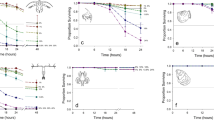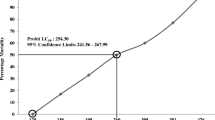Abstract
Small adult zebra mussels (Dreissena polymorpha), 2–8 mm valve length, collected from Lake St. Clair were exposed to a range of concentrations of three biocides in static, acute toxicity tests in the laboratory. Laboratory conditions (22°C; pH 7.8; water hardness ≈ 100 mg/L) were representative of midsummer conditions in the nearshore of Lakes Erie and St. Clair. Mussels actively colonized styrene test substrates which were transferred to three replicate, 1-L test vessels. Sodium hypochlorite was an effective biocide at concentrations exceeding 1.00 mg/L and resulted in complete mortality of mussels by 157 and 264 h at concentrations of 5.00 and 2.50 mg/L, respectively. Poly [oxyethylene (dimethylimino) ethylene (dimethylimino) ethylene dichloride] at 1,2,4 and 8 mg/l and (2-(thiocyanomethylthio) benzothiazole) at 0.5,1,2 and 4 mg/L resulted in 100% mortality at all concentrations in times ranging from 144 to 250 h and 110 to 192 h, respectively. Biocide concentration significantly affected the mean time of death for all three of the compounds tested. Mussel valve length had a significant positive effect on time of death in (2-(thiocyanomethylthio) benzothiazole) but only explained a maximum 18% of the variance. Resistance of these actively colonizing mussels to biocides was greater than that found by other laboratory studies, perhaps because of lowered handling stress in our experimental manipulations.
Similar content being viewed by others
References
Clarke KB (1952) The infestation of waterworks byDreissena polymorpha, a freshwater mussel. J Instn Water Engrs 6:370–378
Fraleigh PC, Matisoff G, Gubanich G, Hoffman GL, Klerke PL, McCall PL, Stevenson RC, Wenning ME (1991) American Water Works Association zebra mussel research project results. In: Proceedings, resources, engineering and operations for the new decade. Annual conference, Philadelphia, pp 103–117
Greenshields F, Ridley JE (1957) Some researches on the control of mussels in water pipes. J Inst Water Eng 11:300–306
Hebert PDN, Muncaster BW, Mackie GL (1989) Ecological and genetic studies ofDreissena polymorpha (Pallas): a new mollusc in the Great Lakes. Can J Fish Aquat Sci 46:1587–1591
Jenner HA (1983) Control of mussel fouling in The Netherlands: Experimental and existing methods. In: Diaz-Tous JAet al. (ed) Symposium on condenser macrofouling technologies. The state-of-the-art, pp 407–421
—(1984) Chlorine minimization in macrofouling control in The Netherlands. In: Jolley RLet al. (ed) Water Chlorination 5:1425–1434
Mackie GL, Gibbons WN, Muncaster BW, Gray IM (1989) The Zebra musselDreissena polymorpha: A synthesis of European experiences and a preview for North America. Report to Ontario Ministry of the Environment, Water Resources Branch, Great Lakes Section. Queen's Printers, Toronto, Ontario, 61 pp plus appendices
Martin ID, Mackie GL, Baker MA (1993) Acute toxicity tests and pulsed-dose delayed mortality at 12 and 22°C in the zebra mussel (Dreisenna polymorpha). Arch Environ Contam Toxicol 24:389–398
McMahon RF, Shipman BN, Ollech JA (1989) Effects of two molluscicides on the freshwater macrofouling bivalves,Corbicula fluminea andDreissena polymorpha. Technical report, Buckman Laboratories, Inc, Memphis, TN
Morton BS (1969a) Studies on the biology ofDreissena polymorpha Pall. I. General anatomy and morphology. Proc Malacol Soc Lond 38:301–321
— (1969b) Studies on the biology ofDreissena polymorpha Pall. II. Correlations of the rhythms of adductor activity, feeding, digestion and excretion. Proc Malacol Soc Lond 38:401–414
— (1969c) Studies on the biology ofDreissena polymorpha Pall. III. Population dynamics. Proc Malacol Soc Lond 38:471–482
Muncaster BW, Hebert PDN, Lazar R (1990) Biological and physical factors affecting the body burden of organic contaminants in freshwater mussels. Arch Environ Contam Toxicol 19:25–34
Nalepa TF, Schloesser DW (1992in press) Zebra mussels: biology, impacts, and control. Lewis Publishers, Boca Raton, FL
Shtegman BK (1964) Biology and control ofDreissena. Trudy Inst Biol Vnuttreonikh Vod 7:1–145
Whitehouse JW, Khalanski M, Sarogola MG, Jenner HA (1985) The control of biofouling in marine and estuarine power stations: A collaborative research working group report for use by station engineers and station managers. Central Electricity Generating Board, Surrey, UK, 48 pp
Wilkinson L (1986) SYSTAT: The System for Statistics. SYSTAT, Inc Evanston, IL
Author information
Authors and Affiliations
Rights and permissions
About this article
Cite this article
Martin, M.D., Mackie, G.L. & Baker, M.A. Control of the Biofouling Mollusc,Dreissena polymorpha (Bivalvia: Dreissenidae), with sodium hypochlorite and with polyquaternary ammonia and benzothiazole compounds. Arch. Environ. Contam. Toxicol. 24, 381–388 (1993). https://doi.org/10.1007/BF01128738
Received:
Revised:
Issue Date:
DOI: https://doi.org/10.1007/BF01128738




